
 United Kingdom (1891-1923)
United Kingdom (1891-1923)HMS Astraea, Bonaventure, Cambrian, Charybdis, Flora, Forte, Fox, Hermione
WW1 RN Cruisers
Blake class | Edgar class | Powerful class | Diadem class | Cressy class | Drake class | Monmouth class | Devonshire class | Duke of Edinburgh class | Warrior class | Minotaur classIris class | Leander class | Mersey class | Marathon class | Apollo class | Astraea class | Eclipse class | Arrogant class | Highflyer class
Pearl class | Pelorus class | Gem class | Forward class | Boadicea class | Blonde class | Active class | Bristol class | Weymouth class | Chatham class | Birmingham class | Birkenhead class | Arethusa class | Caroline class | Calliope class | Cambrian class | Centaur class | Caledon class | Ceres class | Carlisle class | Danae class | Cavendish class | Emerald class
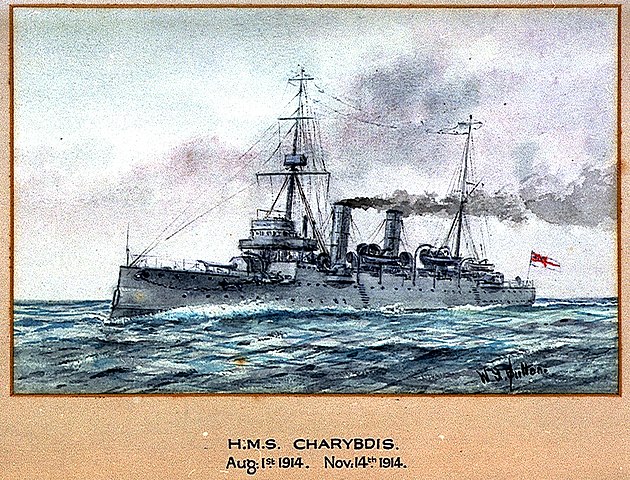
The Astraea class were provided under the Naval Defence Act of 1889 as essentially improved Apollo class cruisers which were criticized as too flimsy. They had an increase of 1000t in displacement to buff up the hull of improve seaworthiness and provide reserve for a better armament. The general arrangement was still overly similar to the Apollo but with better broadside guns, a new full length deck, higher freeboard amidships. They were sheathed in wood and copper for distant, tropical stations. They were all launched in 1893, completed c1894 but still, the class was heavily criticized for the lack of improvement in armament, speed and endurance despite a rising cost. But others appreciated their seaworthiness, and ultimately they formed the basis for future second class cruiser designs. All served in WWI thoughout the Empire unlike the Apollos, essentially decommissioned before 1914.
Development
Provided under the Naval Defence Act of 1889, these vessels were improved Apollos in which an increase of 1000t in displacement was emploved to provide a hull of improved seaworthiness and a slightly heavier and better placed armament. The general arrangement of the hull, protection, armament and machinery was similar to that in the Apollo but the broadside guns were increased to 4-4.7in and 3-6pdr on each side and fitted on a new full length deck provided in place of the separate forecastle and poop.
This greatly increased the freeboard amidships, making the ships drier and giving the guns a higher command. The end 4.7in guns on each side were fitted in sponsons to supplement the 6in weapons in ahead and astern fire. The class was heavily criticised for showing little or no improvement on the Apollos in armament, speed and endurance despite -being larger and more costly, but the fact that the increased weight was largely absorbed in improving seaworthiness was ignored by many of these critics.
Whatever the faults of the design they were certainly improvements on the Apollo class and with a further increase in size formed the basis for future second class cruiser designs. On trials the ships of the class averaged 9250ihp and speeds varied.
These eight cruisers had been ordered under the 1889 Naval Defence Act provisions, defined at the time like improved versions of the Apollo-class cruisers that preceded them. It is not sure if William White was in charge of the redesign, but displacement was augmented from 1,000 tons compared to the Apollos, plus the hull was given improved sea-keeping abilities by replacing the fore and aft castles by a continuous deck. Bulwarks were built at the weather deck level to protect the battery. They were one deck taller amidships and had extended dimensions for extra buoyancy, plus an heavier and better placed armament. This full length deck and higher freeboard amidships however posed now stability issues as the main armament was now higher, raising the metacentric height as well.
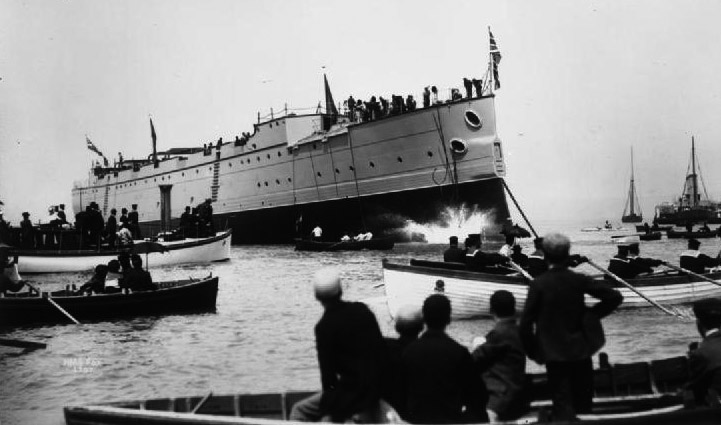
Launching of HMS Fox

Launch ceremony, HMS Bonaventure, christened at Devonport by Princess Marie of Edinburgh.
The design would be later criticized as being way more expensive compared to the Apollos, explaining that only eight ships were authorized, versus twenty-one Apollos. And this was without offering any substantial increase in armament, speed or endurance. Still, they were recognised indeed far more seaworthy, and they setup a design pattern to be followed on future protected cruisers. They were ordered to experienced naval dockyards of Devonport (three), Pembroke (two), Sheerness, Chatham and Portsmouth (one each). Construction was not quick either. Conway’s reference (page 77) did not detail their laying down dates, which is unusual, nor their completion date as seemingly only launching records survived. Based on this, the only known HMS Charybdis (Sheerness) was laid down in 1891 (no date), launched in June 1893 and completed in January 1896, so five years, which was excessive for protected, essentially 2nd class cruisers. To Compare HMS Iphigenia of the Apollo class took two years (1890-1892).
Design of the class
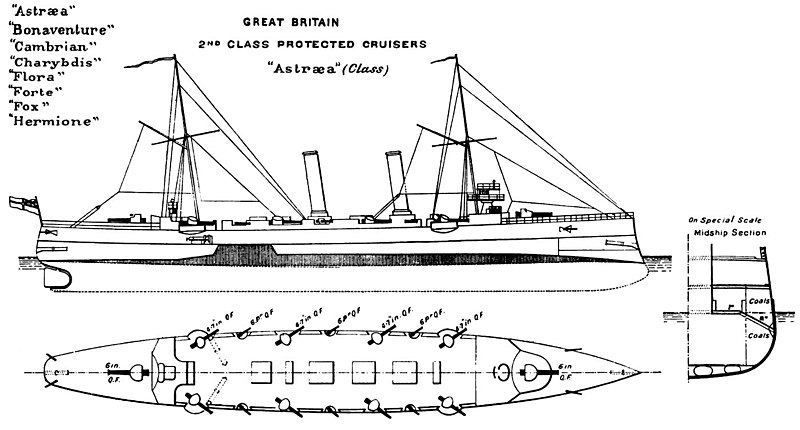
Brassey’s naval annual 1897
Hull and general design
So, the Astraea class had this new taller hull, but still kept a ram bow, a clipper stern with a gallery, and two four-bladed screw propeller. They had two raked masts, two tall, raked funnels far apart, a rather “busy” amidship section between dorade boxes, guns behind bulwarks and ships under davits, six alonsgide and four at the foot of the boom held by the aft mast. They had a structure forward supporting extra light guns, then the forward conning tower (not aft one) with the main bridge built behind and above, comprising an enclosed bridge heavily wooden panelled and an open bridge on top. There was a spotting tub on the mainmast, no sail. Decoration on the prow was moderate. There were large two-doors access to the machinery under the weather deck aft amidship for coaling.
The Astrae were much heavier than the Apollos at 4,360 tons fully loaded versus 3400 to 3600 tonnes for Sheated Apollos so bit less than 1,000 tonnes more. Dimensions were larger, with a
Length between perpendiculars of 320 ft (97.5 m) and 339 ft 6 in (103.48 m) overall versus 300-314 feet, a beam of 49 ft 6 in (15.09 m) versus 43 feet (13.11 to 13.31m) and a draughtn most importantly for 19 ft (5.8 m) versus 17 ft 6 in to keep the metecentric height low. It seems they still managed to be relatively stable despite the odds, with a good enough weight management, rolled reasonably and still being good gun platforms.
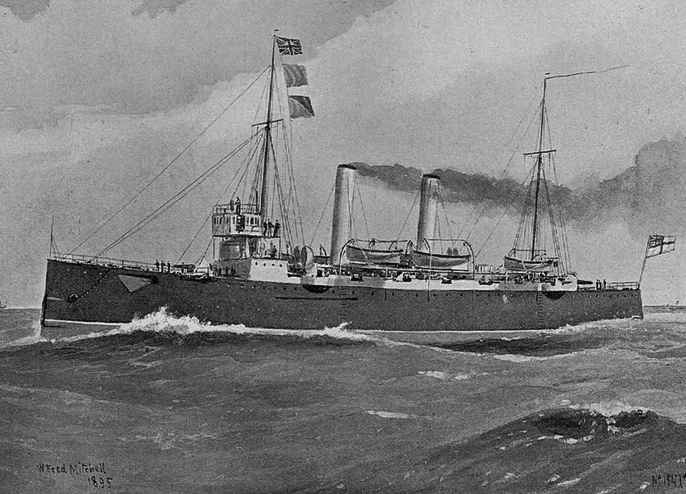
Brassey’s depiction of HMS Fox 1895
Protection
It was a bit better than the Apollo class as well:
No belt, but an Deck 2 in (51 mm) thick with a turtle shape, plunging fore and aft, sloped on both sides, constant thickness (Apollos 1.5-2 in)
The forward conning tower had walls 3 in up to 6 in (76–152 mm), decreasing aft. (Apollos 3 inches all around)
The Gun shields were 4.5 in (110 mm) thick (Apollos same 4-1/2 inches).
The Engine hatch was covered by 5 in (130 mm) stray (Apollos 5-in as well)
Powerplant
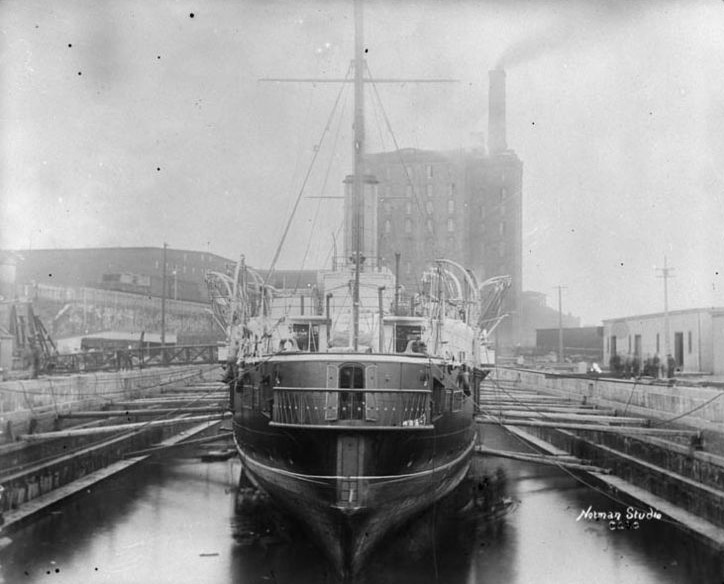
View of the stern gallery in drydock, HMS Charybdis.
Despite the heavier displaceemnt and taller hull, greater buoyancy and beam, no efforts were made to raddically beef up the machinery, which comprised two triple-cylinders vertical triple expansion engines drivinbg two shafts, fed by steam produced by eight 8 cylinder boilers for 7,500 hp (5,600 kW) in natural draught and 9,500 hp (7,100 kW) in forced draught, producing 18 knots (33 km/h; 21 mph) in natural draught and 19.5 knots (36.1 km/h; 22.4 mph) on forced draught, the latter wearing out the machinery. To compare, the Apollos combined three double-ended and two single ended boilers for 7000 ihp and 18.4 knots on natural draught, then 9000 ihp and 20 kts on forcve draught, sheated vessels being slower at 19.7 knots. So they ended up slower than their forebears, something critical for a cruiser.
As for range, the large hull of the Astrae was to be a bonanza with their 1000 tons of coal versus 535 tonnes on the Apollos but this gave them “only” 7,000 nautical miles ot 13,000 km; 8,100 miles of range at the cruising speed of 10 knots (19 km/h; 12 mph) versus 8000 nautical miles at the same speed. So they were less efficient steamer.
Armament
At least on this chapter some improvement was awaited. As completed, these cruisers had the following:
Two QF 6-inch (152.4 mm) guns, eight QF 4.7 in (120 mm) guns, ten QF 6-pounder 57 mm (2.2 in) guns and a single QF 3-pounder 47 mm (1.9 in) guns plus four 18 in (45 cm) torpedo tubes.
The Apollos had just two less QF 4.7 in and two less 6-pounder and the benefit of four machine guns for landing parties and smaller torpedo tubes of 14 inches. Many in the admiralty believed this was not worth the addition of 1,000 tonnes.
Main Elswick QF 6-inch
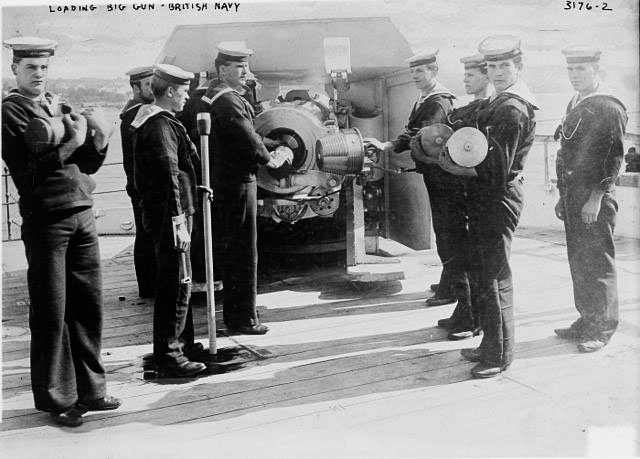
Photo: The crew of a 6-in Mark I on HMS Ariadne.
These were essentially the same models as the previous Apollos, Vickers 152mm/40 QF Mk I/II, installed fore and aft in the axis. Both had a thick protective shield, good against shrapnels, even direct hit from a 4-in gun.
⚙ specifications QF 6-inch Mark I |
|
| Weight | 6.6 tons |
| Barrel lenght | 240 inches (6.096 m) |
| Elevation/Traverse | -5/+20 degrees, +150/-150 degrees |
| Muzzle velocity | 2,154 feet per second (657 m/s) |
| Range | 10,000 yards (9,140 m) at 20° |
| Guidance | Optical, spotting data |
| Crew | 9 |
| Round | QF, separate cartridge and shell 100 pounds (45 kg) |
| Rate of Fire | 5–7 rounds per minute |
Secondary Elswick QF 4.7 in
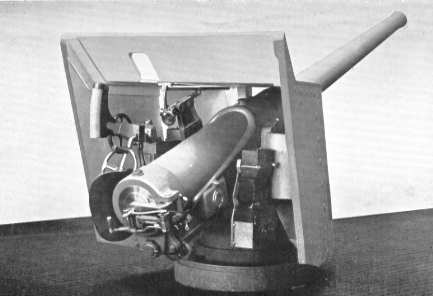
These eight 120mm/40 QF Mk I/II/III/IV guns meant four per side, all on the weather deck behind man-tall bulwark, offering light protection against shrapnel. Four at on the corners, sponsoned to fire fore and aft in addition to the main guns and four broadside-capable only. They were aso protected by enveloping shield ensuring additional protection against shrapnel.
⚙ specifications QF 4.7 in/40 |
|
| Weight | c4 tons |
| Barrel lenght | Unknown, caliber 4.724 inches (120 mm) |
| Elevation/Traverse | -6° – 20° |
| Loading system | Single motion interrupted screw breech |
| Muzzle velocity | 2,150 feet per second (660 m/s) |
| Range | 10,000 yards (9,100 m) at 20° |
| Guidance | Optical |
| Crew | 6 |
| Round | HE 45 pounds (20.41 kg) |
| Rate of Fire | 5–6 rounds per minute |
Light Guns
QF 6-pounder 57 mm (2.2 in) guns

These 57m/40 6pdr Hotchkiss Mk I were placed into four fore and aft hull casemates, then six either side of the amidship bulwark. They were small enough to be one manned, with two assistants with the rounds.
⚙ specifications 6-pdr (2.244 in) |
|
| Weight | 821–849 lb (372–385 kg) barrel & breech |
| Barrel lenght | 8.1 ft (2.5 m), barrel 7.4 ft (2.3 m) 40 caliber |
| Elevation/Traverse | -5 +20° |
| Loading system | Vertical sliding-block, Hydro-spring 4 inch recoil |
| Muzzle velocity | 1,818 feet per second (554 m/s) |
| Range | 4,000 yards (3,700 m) |
| Guidance | Optical, Eyeball Mark I |
| Crew | 4 |
| Round | HE Fixed QF 57x307R 6 lb (2.7 kg)/9.7 lb (4.4 kg) full |
| Rate of Fire | 25 rpm |
QF 3-pounder 47 mm (1.9 in) guns
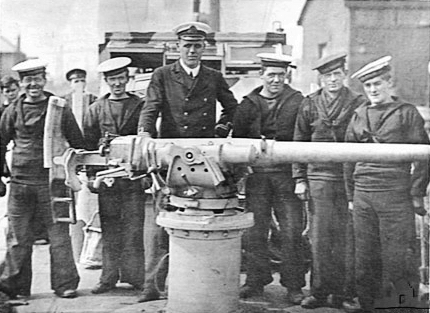
The location of this single gun is unknown, perhaps on the aft structure upper deck. It was probably usable on a wheeled undercarriage to be placed on the steam cutter and used to reinforced a landing party. Classic 47mm/40 3pdr Hotchkiss Mk I.
⚙ specifications 3-pdr Hotchkiss (1.9 in) |
|
| Weight | 240 kg (530 lb) |
| Barrel lenght | 2 m (6 ft 7 in), barrel 1.8 m (5 ft 11 in) 40 caliber |
| Elevation/Traverse | |
| Loading system | Vertical sliding-wedge |
| Muzzle velocity | 571 m/s (1,870 ft/s) |
| Range | 5.9 km (3.7 mi) at +20° |
| Guidance | Optical, Eyeball Mark I |
| Crew | |
| Round | Fixed QF 47 × 376 mm R, full 3 kg (6.6 lb), shell 1.5 kg (3.3 lb) |
| Rate of Fire | 30 rpm |
It should be noted that some sources gives an additional four 11.4 mm/87 machine guns. No information available on the type and use.
Torpedo Tubes
The four 18 inches (45 cm) torpedo tubes were a real improvement over the “puny” 14-inches (356 mm) models which performances were sub-par. They were placed in four locations, two amidship above water, one at the stern and one forward in the prow.
The Whitehead 18-inches measured 11 feet in lenght, for 18 inches diameter and weighted 836 pounds. It was powered by a three cylinder engine, driven by compressed air, launched by a small powder charge to 26 knots at 1000 yards carrying a 110 pounds Guncotton warhead.
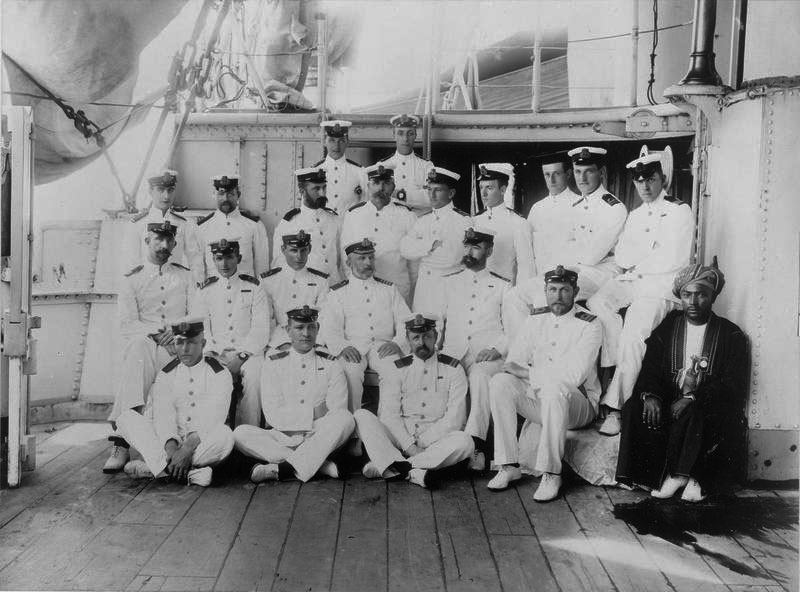
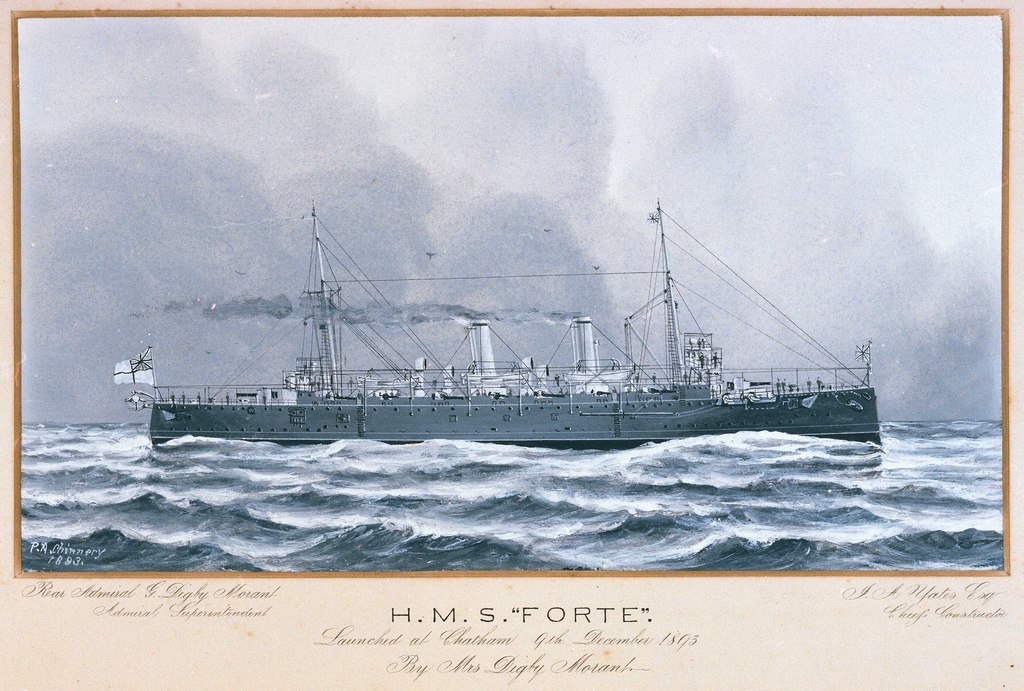


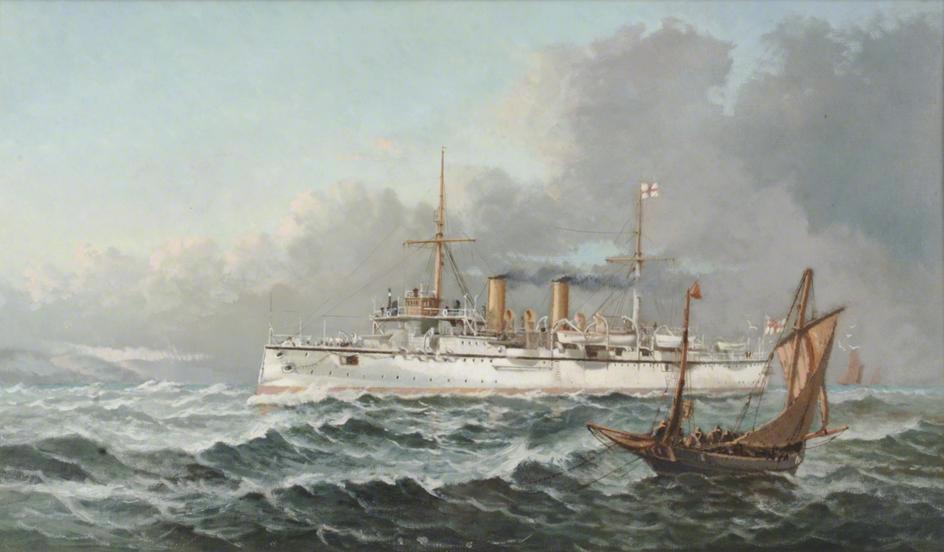

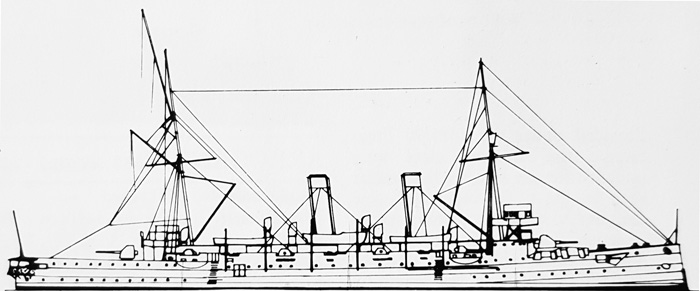
Conways profile
⚙ specifications |
|
| Displacement | 4,360 tons |
| Dimensions | 339 ft 6 in x 49 ft 6 in x 19 ft (103.48 x 15.09 x 5.8 m) |
| Propulsion | 3-cyl. VTE, 8 cyl. boilers, 2 shafts 7,500 hp natural, 9,500 hp forced |
| Speed | 18 knots natural, 19.5 knots (36.1 km/h; 22.4 mph) forced draught |
| Range | 1000 tons coal: 7,000 nautical miles (13,000 km; 8,100 mi) at 10 kts |
| Armament | 2× QF 6-in, 8× QF 4.7 in, 10× QF 6-pdr, 1× QF 3-pdr, 4 × 18 in TTs |
| Protection | CT 3–6 in, Deck 2 in, Gun shields 4.5 in, Engine hatch 5 in |
| Crew | 318 |
 HMS Astraea (1893)
HMS Astraea (1893)

Astraea was laid down at Devonport Dockyard in 1891 (presumably), launched on 17 March 1893, 5 November 1895. She served in the Mediterranean from early 1900 under command of Captain Alfred Paget and China in 1896 under command of Captain Casper Joseph Baker until leaving Hong Kong on 27 March 1902, for home via Singapore on 2 April, Colombo on 10 April, Suez on 27 April, Malta on 2 May, reaching Plymouth on 14 May with the DD HMS Skate, paid off at Chatham on 12 June 1902, B Division Fleet Reserve.
She was reactivated and sent to the China Station in 1906, then Colombo 1908-1911, back home for refit on January 1912, recommissioned at the Nore, June 1912, 3rd Fleet. April 1913 she was reassigned to the Cape of Good Hope, West Africa Station.
She cruised between East Africa at Zanzibar wheh the war broke out, and she was tasked to protect trade routes around the African coast. On 8 August 1914 she shelled the German-held port of Dar-es-Salaam (German East Africa’s main port); She notably blasted the radio station. The Germans scuttled their floating dock and blocked themselves the harbour. Thus, the German commerce raider SMS Königsberg could not be hosted. After a while, Astraea was tasked to puchased the cruiser sown to the Rufiji Delta. By May 1915 one senior naval officer reported, while en route for the invasion of Kamerun, a Ghostly encounter, relative (deceased) wartime poet Wilfred Owen. After her African campaign, HMS Astraea returned home. The Navy had new C and D class cruisers than needed crews and so she was paid off in July 1919, sold 1 July 1920 to Castle, then resold, BU in Germany.
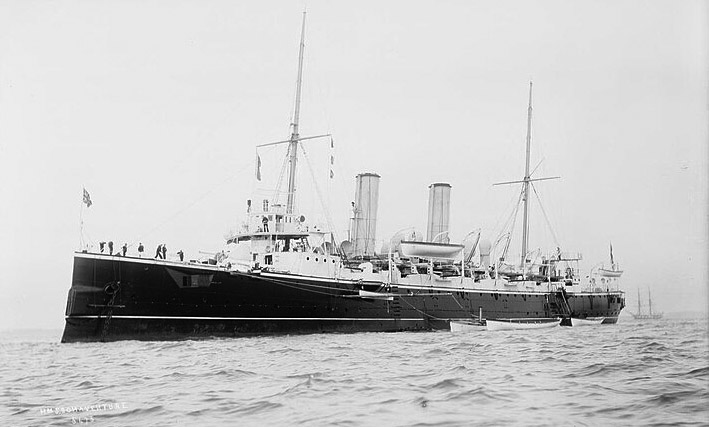
HMS Bonaventure as completed
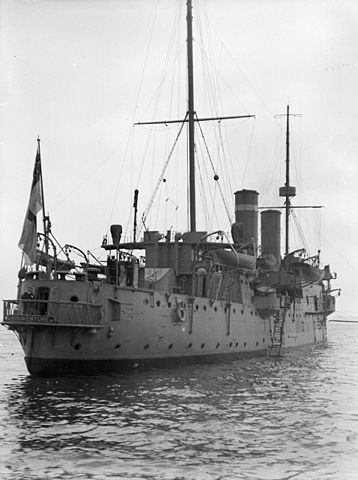 Bonaventure was laid down at Devonport Dockyard, launched on 2 December 1892, completed on 5 July 1894. She served in the Pacific Squadron, took part in the 3rd China War under command of Captain Robert Montgomerie. She was back home in May 1906 to Devonport to be paid off. She was sent to Haulbowline Dockyard in Cork, Ireland, converted into a depot ship for submarines, work completed in April 1907. She served as such during the First World War and later was paid off on 17 October 1919, sold on 12 April 1920 to Forth Ship Breaking Company in Bo’ness.
Bonaventure was laid down at Devonport Dockyard, launched on 2 December 1892, completed on 5 July 1894. She served in the Pacific Squadron, took part in the 3rd China War under command of Captain Robert Montgomerie. She was back home in May 1906 to Devonport to be paid off. She was sent to Haulbowline Dockyard in Cork, Ireland, converted into a depot ship for submarines, work completed in April 1907. She served as such during the First World War and later was paid off on 17 October 1919, sold on 12 April 1920 to Forth Ship Breaking Company in Bo’ness.
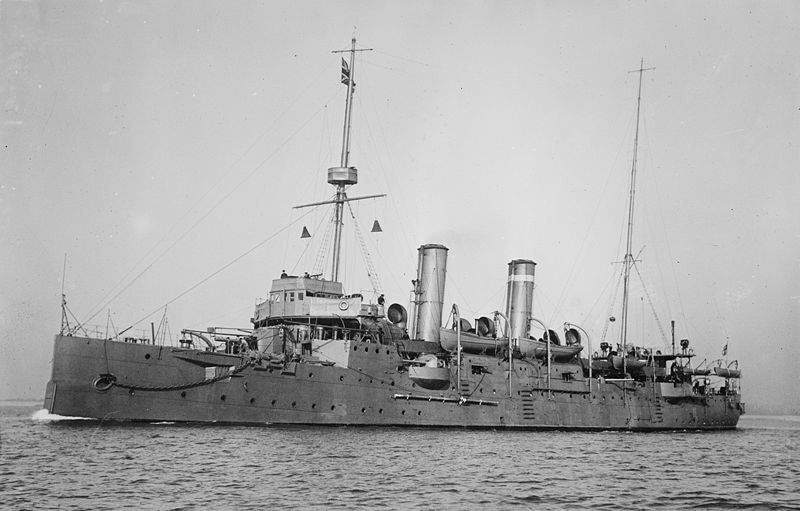
HMS Bonaventure before becoming a depot ship, 1906
 HMS Cambrian (1893)
HMS Cambrian (1893)
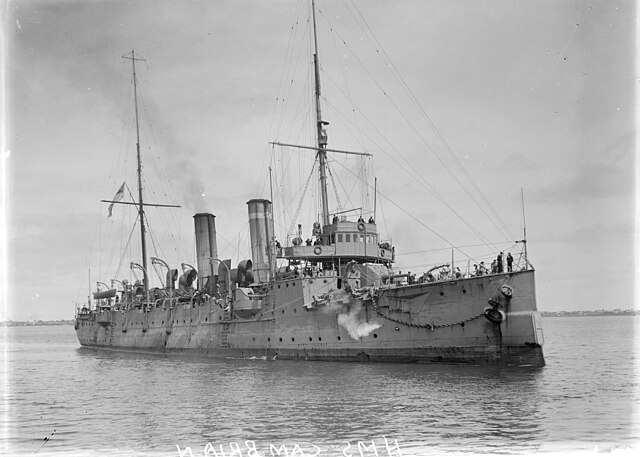
Cambrian was laid down at Pembroke Dockyard, launchrf on 30 January 1893, completed on an unknown date. She was the last flagship of the Australia Station, commande by Prince Louis of Battenberg, later First Sea Lord in the Mediterranean Fleet from October 1894 to May 1897 at first, and by March 1901 she was commissioned at HMNB Devonport (Captain Frederick Sidney Pelham) with a special 345 crew of future NCOs and officers to become senior officer on the South East Coast, America Station. From May 1901 she was under Commodore Robert Leonard Groome, then Captain Frank Finnis was at the head of the South East American Station, Cambrian was its flagship by June 1902. In August, Commander Edward Stafford Fitzherbert became captain and the cruiser sailed to Montevideo and Santos, in Brazil, then Bahia and Rio de Janeiro, down to the Falkland Islands in early 1903.
In 1907 she was back at the Mediterranean Station. Next she was at the Australia Station on 3 October 1905 under Captain Ernest Gaunt, sailing to Sydney by December. She seized the Ashmore and Cartier Islands, Indian Ocean, on behalf of the United Kingdom. She left the Austrlian station when the Australian Navy received its new ships and returned home by 13 October 1913, being paid off. She was converted into a base ship as “HMS Harlech” in March 1916, then “HMS Vivid” in September 1921, until sold in 1923 to Young, Southerland, BU.
 HMS Charybdis (1893)
HMS Charybdis (1893)
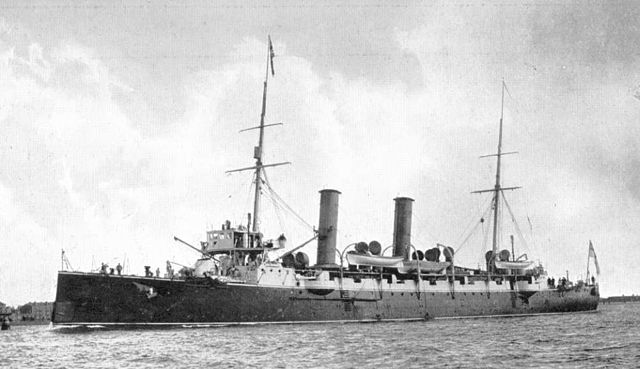
HMS Charybdis as completed
Charybdis was laid down at Sheerness Dockyard, launched on 15 June 1893, completed on 14 January 1896. She served on a number of foreign stations, in Indian and Pacific Ocean, Cape of Good Hope. She was considered Obsolete by the outbreak of the First World War, and was used in secondary roles as depot ship. Charybdis spent most of her career in British waters, with occasional voyages to the Indian Ocean and Far East commands. She was part of the 12th Cruiser Squadron in 1914 but was damaged in a collision in 1915, laid up at Bermuda. She was used for harbour service from 1917 and converted to a merchant vessel, loaned to a shipping firm in 1918, returned to the RN in 1920, sold in 1922, BU in 1923.
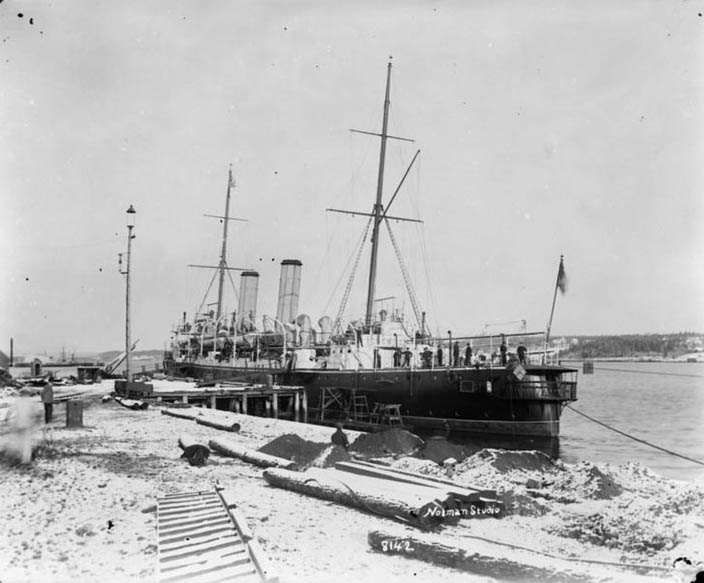
Charybdis in Halifax, winter 1900
 HMS HMS Flora (1893)
HMS HMS Flora (1893)

Flora was laid down at Pembroke Dockyard, launched on 21 November 1893, completed on an unknown date. She served under command of Commodore Robert Leonard Groome and later of Captain Frederick Sidney Pelham, South East Coast, America Station until June 1901. She was back to Devonport and paied off, recommissioned on 11 November 1902 and sent on the Pacific station to relieve HMS Phaeton, leaving Plymouth in late November, stopped in Funchal, Saint Vincent, Pernambuco, Montevideo. She was the subject of a famous salvage operation after running aground in 1903.
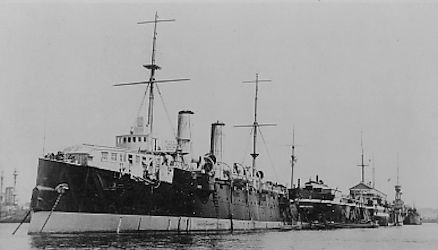
HMS “Indus II” at Devonport in October 1915
In 1914 she was to be sold, but remained in harbour service, by April 1915 being renamed TS Indus II, and sold for good on 12 December 1922, BU at Dover.
 HMS Forte (1893)
HMS Forte (1893)
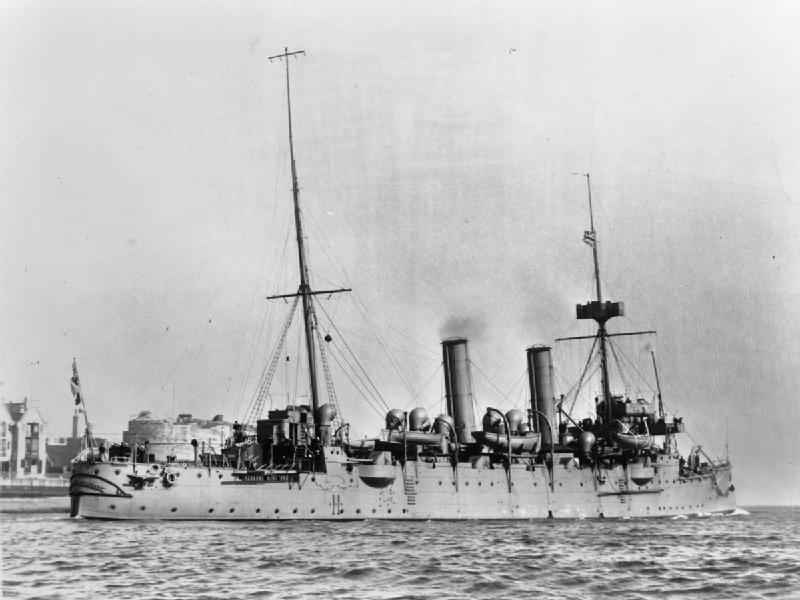
Forte was laid down at Chatham Dockyard, launched on 9 December 1893, completed on an unknown date. HMS Forte served on the Cape and West African stations, stopped in Sierra Leone and Gambia by January 1901 and by December 1902 she was on the East Africa station and carried British colonial secretary Joseph Chamberlain and his wife from Mombasa to Zanzibar. In 1908 her gunners showed such poor performances this led to a Court of Inquiry blaming Captain John Green and officers for insufficient training, notably for gun laying safety and test procedure. In 1910, Captain Green would ran his cruiser aground and was blamed again for the “unseamanlike manner in which the ship was navigated”. In 1913 Forte was placed on the selling list, sold on 2 April 1914 for scrapping and thus was the only one in her class to miss the First World War.
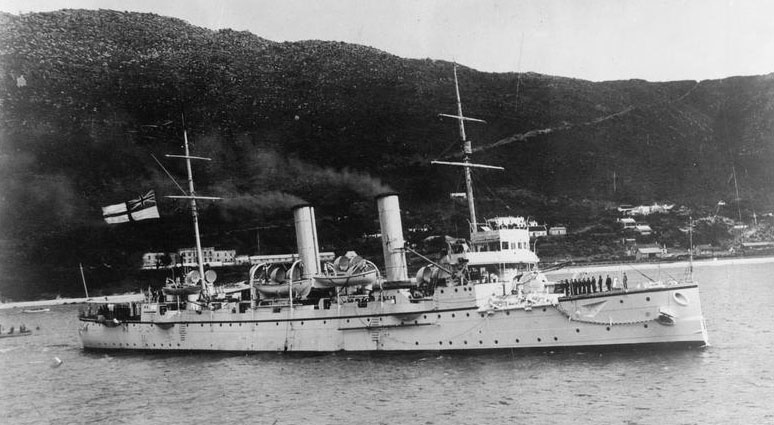
Forte off Zanzibar in 1899, note the white colonial livery
 HMS Fox (1893)
HMS Fox (1893)
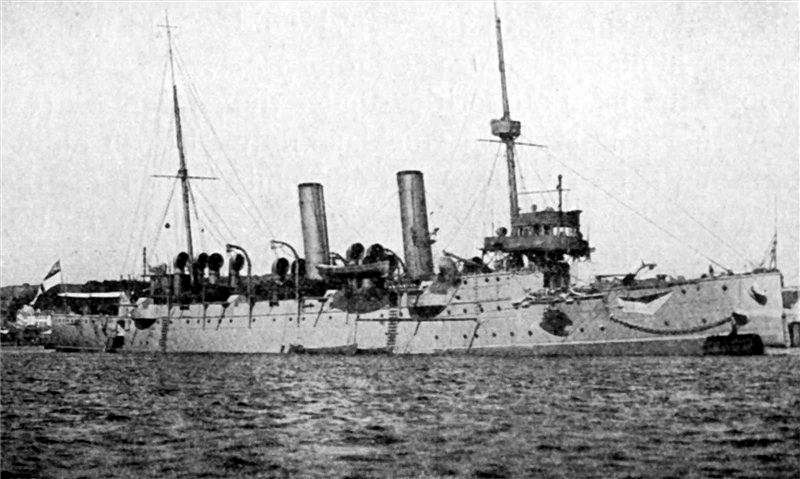
Fox was laid down at Portsmouth Dockyard, launched on 15 June 1893, completed on 14 April 1896. Fox relieved HMS Marathon on the East Indies Station, making her trials and short shakedown in the Channel, arrived at Malta on 28 October, Aden on 11 November, Bombay, but back to Kuwait by January 1902 carrying six small guns presented by the British to Sheikh Mubarak to ease tensions between Britain and Turkey in the Persian Gulf. By September 1902 she was in Colombo, after escorting SS Nithsdale which collided near the Maldives. Next she was based at Trincomalee. By late December 1902 she visited Bandar Abbas, and assisted the population after an earthquake. By April 1904 HMS Fox supported the Somaliland Campaign, supplying men for a large landing party capturing the forts at Illig and she covered the operation by artillery. She went back home to be paid by January 1907, sent to the reserve.
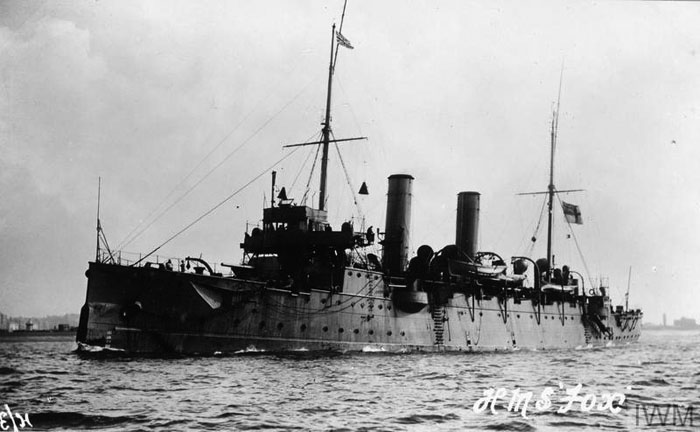
In May 1908, she was recommissioned and assigned to the Home Fleet and by June 1908, assigned to the East Indies where station until 1914. She was sent Off Colombo to intercept and capture two German merchant ships (“Australia” on 10 August 1914, “Holtenfels” on 11 August 1914). 3-4 November saw her supporting Indian-British troops trying to capture the German port of Tanga, German East Africa and later she took part in the hunt for SMS Königsberg and the raid on Dar-es-Salaam, bombarding and blockading the port. In January 1915 she was in the fleet capturing Mafia Island.
She alternated between the East Indies and Egypt from 1915 to 1917; the Red Sea in 1917 to 1918, playing a major part by supporting the Arab Revolt notably being the HQ ship for William Boyle, 12th Earl of Cork. In 1919 she took part in the British intervention in the Russian Civil War, making her, despite her age, the most exprienced, most useful cruiser of her class in a very long career.
She was sold in 1920 to a Watchet Harbour shipbreaker (Somerset), largest vessel ever to be scrapped here.
 HMS Hermione (1893)
HMS Hermione (1893)
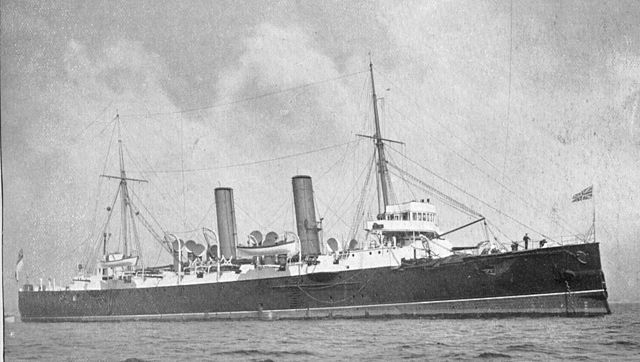
Hermione was laid down at Devonport Dockyard, launched on 7 November 1893, completed on 14 January 1896. By 1896 Hermione (Captain Charles R. Arbuthnot, yes, this one) was assigned a new squadron to be sent in the Boer war after the failured Dr. Jameson’s Raid. The “Particular Service Squadron” sailed to Sputh Africa under Rear-Admiral Alfred Taylor Dale (flagship HMS Revenge). Next, Hermione was assigned to the China Station in 1898. In 1900 she took part in the 3rd China/Boxer Rebellion. From December 1899 to April 1900, her Royal Marines were sent as honour guard/pallbearers for the funerals of Governor Sir Charles Mitchell and Chief Justice (Supreme Court China-Korea) Sir Nicholas John Hannen, consul-general in Shanghai.
In May 1902 she was reassigned to the Mediterranean station, cruiser division, stopping in Argostoli by October 1902. By 1906 Hermione she was placed in reserve at Portsmouth and was refitted in 1907, then joined the Cape Town Station. On 14 February 1909 she ran aground at Zanzibar, and was re-floated with slight damage. In June 1909 she joined the 3rd Cruiser Squadron, Portsmouth and Home Fleet. On 6 August 1909 she ran aground off Killingholme, Humber and again was re-floated withiout much damage. Afterward she was reconverted as tender by September 1910 for RN first airship until the project was abandoned and was back to Home Fleet in January 1912 but tested the seaplane Avro Type D in November 1911.
In 1913-1914 she was sent off the Mexico, Tampico, to protect British interests and citizens. In April-May 1914 she was there during the Tampico Affair as U.S. forces occupied Veracruz. While refugees tried to flee the city, H.M.S. Hermione sent a party of Royal marines and armed sailors to try ro evacuate the refugees from Tampico. By August 1914, she was back home, assigned as guard ship at Southampton, then HQ Ship for motor launches/coastal motor boats, from December 1916 to December 1919. She was Sold off in October 1921, resold on 18 December 1922, renamed “Warspite”, scrapped in… September 1940.
Read More/Src
Books
Colledge, J. J.; Warlow, Ben (2006). Ships of the Royal Navy: Complete Record: Chatham Publishing.
Gardiner, R; Chesneau, Roger; Kolesnik, E M.; Campbell, N. J. M. (1979). Conway’s All the World’s Fighting Ships 1860–1905.
Gardiner, Robert; Gray, Randal; Budzbon, Przemysław (1985). Conway’s All the World’s Fighting Ships 1906–1921.
Jane’s Fighting Ships of World War One. New York: Military Press. 1990.
Links
http://www.navypedia.org/ships/uk/brit_cr_astraea.htm
https://www.britishempire.co.uk/forces/navyships/cruisers/hmsastraea.htm
https://www.battleships-cruisers.co.uk/astraea_class.htm
https://www.naval-history.net/OWShips-WW1-05-HMS_Astraea.htm
http://www.historyofwar.org/articles/weapons_astraea_class_cruisers.html
https://www.rmg.co.uk/collections/objects/rmgc-object-67204
https://lewin-of-greenwich-naval-history-forum.co.uk/forum/viewtopic.php?t=1823
https://www.worldwar1.co.uk/light-cruiser/hms-Astraea.html
https://www.history.navy.mil/our-collections/photography/numerical-list-of-images/nhhc-series/nh-series/NH-68000/NH-68731.html
https://www.battleships-cruisers.co.uk/hms_hermione.htm
https://www.worldnavalships.com/astraea_class.htm
https://en.wikipedia.org/wiki/Astraea-class_cruiser
https://commons.wikimedia.org/wiki/Category:Astraea_class_cruiser_(1893)

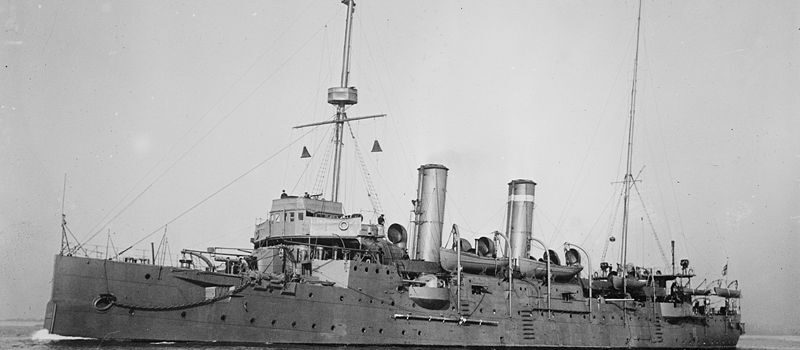
 Latest Facebook Entry -
Latest Facebook Entry -  X(Tweeter) Naval Encyclopedia's deck archive
X(Tweeter) Naval Encyclopedia's deck archive Instagram (@navalencyc)
Instagram (@navalencyc)





 French Navy
French Navy Royal Navy
Royal Navy Russian Navy
Russian Navy Armada Espanola
Armada Espanola Austrian Navy
Austrian Navy K.u.K. Kriegsmarine
K.u.K. Kriegsmarine Dansk Marine
Dansk Marine Nautiko Hellenon
Nautiko Hellenon Koninklije Marine 1870
Koninklije Marine 1870 Marinha do Brasil
Marinha do Brasil Osmanlı Donanması
Osmanlı Donanması Marina Do Peru
Marina Do Peru Marinha do Portugal
Marinha do Portugal Regia Marina 1870
Regia Marina 1870 Nihhon Kaigun 1870
Nihhon Kaigun 1870 Preußische Marine 1870
Preußische Marine 1870 Russkiy Flot 1870
Russkiy Flot 1870 Svenska marinen
Svenska marinen Søværnet
Søværnet Union Navy
Union Navy Confederate Navy
Confederate Navy Armada de Argentina
Armada de Argentina Imperial Chinese Navy
Imperial Chinese Navy Marinha do Portugal
Marinha do Portugal Mexico
Mexico Kaiserliche Marine
Kaiserliche Marine 1898 US Navy
1898 US Navy Sovietskiy Flot
Sovietskiy Flot Royal Canadian Navy
Royal Canadian Navy Royal Australian Navy
Royal Australian Navy RNZN Fleet
RNZN Fleet Chinese Navy 1937
Chinese Navy 1937 Kriegsmarine
Kriegsmarine Chilean Navy
Chilean Navy Danish Navy
Danish Navy Finnish Navy
Finnish Navy Hellenic Navy
Hellenic Navy Polish Navy
Polish Navy Romanian Navy
Romanian Navy Turkish Navy
Turkish Navy Royal Yugoslav Navy
Royal Yugoslav Navy Royal Thai Navy
Royal Thai Navy Minor Navies
Minor Navies Albania
Albania Austria
Austria Belgium
Belgium Columbia
Columbia Costa Rica
Costa Rica Cuba
Cuba Czechoslovakia
Czechoslovakia Dominican Republic
Dominican Republic Haiti
Haiti Hungary
Hungary Honduras
Honduras Estonia
Estonia Iceland
Iceland Eire
Eire Equador
Equador Iran
Iran Iraq
Iraq Latvia
Latvia Liberia
Liberia Lithuania
Lithuania Mandchukuo
Mandchukuo Morocco
Morocco Nicaragua
Nicaragua Persia
Persia San Salvador
San Salvador Sarawak
Sarawak Uruguay
Uruguay Venezuela
Venezuela Zanzibar
Zanzibar Warsaw Pact Navies
Warsaw Pact Navies Bulgaria
Bulgaria Hungary
Hungary

 Bundesmarine
Bundesmarine Dutch Navy
Dutch Navy Hellenic Navy
Hellenic Navy Marina Militare
Marina Militare Yugoslav Navy
Yugoslav Navy Chinese Navy
Chinese Navy Indian Navy
Indian Navy Indonesian Navy
Indonesian Navy JMSDF
JMSDF North Korean Navy
North Korean Navy Pakistani Navy
Pakistani Navy Philippines Navy
Philippines Navy ROKN
ROKN Rep. of Singapore Navy
Rep. of Singapore Navy Taiwanese Navy
Taiwanese Navy IDF Navy
IDF Navy Saudi Navy
Saudi Navy Royal New Zealand Navy
Royal New Zealand Navy Egyptian Navy
Egyptian Navy South African Navy
South African Navy






























 Ukrainian Navy
Ukrainian Navy dbodesign
dbodesign